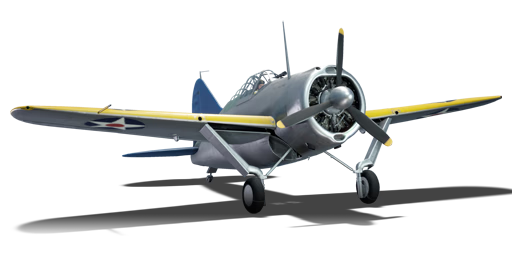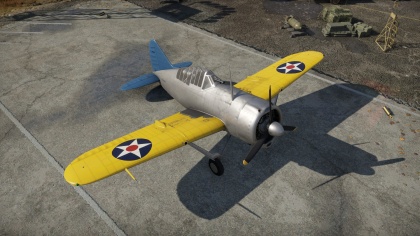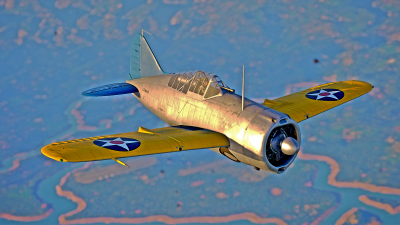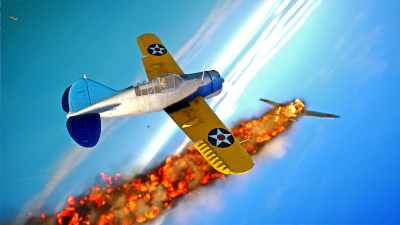F2A-1
Contents
| This page is about the American fighter F2A-1. For the premium version, see Thach's F2A-1. For the other version, see F2A-3. |
Description
The F2A-1 Buffalo is a rank American naval fighter
with a battle rating of (AB), (RB), and (SB). It has been in the game since the start of the Open Beta Test prior to Update 1.27.
The Brewster F2A Buffalo was the first carrier-based monoplane of the US fleet, made to replace the outdated biplanes in service with the US Navy. It had a 950 horsepower engine and a total of four machine guns. The nose armament consists of two machine guns of different calibre, a 0.50 calibre (12.7 mm) and a 0.30 calibre (7.62 mm). Each wing is also equipped with a 0.50 calibre for two more machine guns. Many countries ordered the Buffalo, including the Finnish Air Force which was highly successful with theirs against Russian fighters. But by the time WW2 started, and the Attack on Pearl Harbor, the F2A was outclassed by the Japanese A6M2 and Ki-43s.
The F2A-1 is a competitive machine if using the proper tactics versus the proper enemy. The Buffalo can outrun biplanes and can out-turn most monoplanes. This plane will get a pilot used to the American style of playing using Boom & Zoom, and armaments of .50 calibre machine guns.
General info
Flight performance
| Characteristics | |||||||
|---|---|---|---|---|---|---|---|
| Stock | |||||||
| Max Speed (km/h at 4,600 m) |
Max altitude (meters) |
Turn time (seconds) |
Rate of climb (meters/second) |
Take-off run (meters) | |||
| AB | RB | AB | RB | AB | RB | ||
| 484 | 468 | 19.1 | 19.7 | 7.8 | 7.8 | 250 | |
| Upgraded | |||||||
| Max Speed (km/h at 4,600 m) |
Max altitude (meters) |
Turn time (seconds) |
Rate of climb (meters/second) |
Take-off run (meters) | |||
| AB | RB | AB | RB | AB | RB | ||
| 527 | 504 | 17.4 | 18.2 | 14.8 | 10.9 | 250 | |
Details
| Features | ||||
|---|---|---|---|---|
| Combat flaps | Take-off flaps | Landing flaps | Air brakes | Arrestor gear |
| ✓ | ✓ | ✓ | X | ✓ |
| Limits | ||||
|---|---|---|---|---|
| Wing-break speed (km/h) |
Gear limit (km/h) |
Combat flaps (km/h) |
Max Static G | |
| + | - | |||
| 460 | ~11 | ~5 | ||
| Optimal velocities | |||
|---|---|---|---|
| Ailerons (km/h) |
Rudder (km/h) |
Elevators (km/h) |
Radiator (km/h) |
| < 405 | < 400 | < 380 | > 306 |
| Compressor (RB/SB) | ||
|---|---|---|
| Setting 1 | ||
| Optimal altitude | 100% Engine power | WEP Engine power |
| 1,800 m | 860 hp | 963 hp |
| Setting 2 | ||
| Optimal altitude | 100% Engine power | WEP Engine power |
| 4,650 m | 760 hp | 851 hp |
Survivability and armour
- No armour
- Self-sealing fuel tanks (1 in each wing)
Armaments
Offensive armament
The F2A-1 is armed with:
- 1 x 12.7 mm Browning M2 machine guns, nose-mounted (250 rpg)
- 2 x 12.7 mm Browning M2 machine guns, wing-mounted (400 rpg = 800 total)
- 1 x 7.62 mm Browning machine gun, nose-mounted (450 rpg)
Usage in battles
The best way to fly this aircraft would be as a Boom & Zoom or energy fighter; it can outrun most aircraft it faces unless it is up-tiered and faces something like the Bf 109 F-1. In such a scenario the best way to destroy more advanced vehicles is through boom and zoom tactics.
In Arcade, there is no need to worry about ammo count as much as in Realistic Battles (RB) and Simulator (SB) since the planes can reload in the air. The target-lead indicator, which shows approximately where their enemy plane will be when the bullets reach the target, also assists aiming. For Arcade, the ammo belts are really useful, it is suggested to use Omni-purpose ammo for the .50 calibre (12.7 mm) machine gun and Stealth for the .30 cal (7.62 mm) machine gun. However, another option is to try going all stealth so the F2A can surprise the enemy with bullets they can't see. There are a variety of enemy planes that the F2A-1 faces, ranging from biplanes to low-rank monoplanes.
In the common low-rank Arcade Battle, fur-balls at low altitude are very common, with planes trying to get on each other's tail, a perfect set up for a Boom & Zoomer like the Buffalo. First set the attack angle, which could be from directly above the enemy that is targeted, or from behind (it should be priority to target enemy planes that are chasing friendly planes or for a dangerous threat like MiG-3s, LaGG-3s, Hurricanes, Bf 109s or other Buffaloes). Once the F2A has made a pass on the enemy plane, what happens next depends on the identity of the target. If the attack didn't destroy them on the first pass, and the enemy is a biplane, then keep up the speed and vacant the area, and set up another pass. If the enemy is a monoplane in the same situation, the F2A can choose to either clear the area, or turn onto their tail, but it is advisable to leave the area and check whether the enemy noticed the attacking F2A. If not, and he is chasing a friendly aircraft or going for ground targets, then latch on to his tail and shoot him down!
In Realistic Battles & Simulator Battles, most of the tactics against fighters would be the same as in Arcade, only with a few restrictions.
- Do not dive too fast, the F2A won't be able to pull up or the plane's wings will break.
- No Enemy-Lead indicator, pilot skill and intuition will be required to estimate where the enemy plane will be when the bullets reach the targets.
- Very limited ammo, plus the armament isn't reliable outside of 400 meters.
So how does one play this in RB with all these drawbacks? A few very simple things will help with those problems: at the beginning of the match in RB, climb at about a 15 degree angle until about 3,000 - 4,000 m in altitude. When an enemy is spotted, if a biplane the F2A will have to take up a Boom & Zoom tactic, do not attempt to turn fight. If the enemy is a monoplane, turn-fighting can be a valid tactic; unless they are the British Hurricane or Japanese A5M (not to be confused with the A6M, which is much superior to the Buffalo) or Ki-43, then do not turn fight these monoplanes. For the most part, Russian monoplanes are safe to turn fight (I-16s, MiG-3s and LaGG-3s). When diving on an enemy, put the throttle to 0% so the F2A does not accelerate too fast. If a shot can't be gained on the enemy, pull out by putting throttle at 100% and point the nose up to gain altitude. Once on the tail of an enemy, no matter the plane, open fire only at close ranges, firing at 300 meters or less will help conserve ammo and lessens the need to lead your aim, therefore making each shot more effective.
Surprisingly, especially at its BR, the Buffalo can be effectively used as a CAS fighter in Ground RB. Using the armour piercing rounds for the M2, this plane can not only destroy soft targets such as open-top AA vehicles, but also damage a majority of its tanks in its BR from the top. For maximum efficiency, after spawning in the Buffalo, increase altitude to around 1,500 m to 2,000 m, scouting potential ground targets and/or incoming air threats (enemy dive bombers like the Ju87 with heavy bomb loads must be a priority target as it can cause a lot of damage to your allies). If the skies are clear, drop the throttle to 0%, dive down at an enemy (preferably in a vertical angle to minimise the enemy armours' angling effect) and send your .50 calibre rounds right through the enemy's turret. With the Buffalo's superior firepower, you will most likely disable, or if you are lucky, knock out the enemy with a single pass. As you exit the pass, throttle your engine to WEP as you climb back to your original altitude. Rinse and repeat, you will be a formidable threat to your enemies.
This can apply to all three game-modes: When someone is on the F2A's tail and bullets fly past the plane, with the right altitude, make a short steep dive. With that little dive, it can dodge enemy bullets and it gives an opportunity to take a look back at the offending enemy. If the aircraft is a biplane, continue the dive and get out of range of their guns. If it is a monoplane, attempt to turn fight, but the F2A is still effective in diving away from even faster monoplanes, which will be effective against manoeuvrable monoplanes like the Hurricane and A5M4. Learning the gun sounds also helps, sometimes the sound will help identify the enemy plane so as to make a move more instinctively.
Manual Engine Control
| MEC elements | ||||||
|---|---|---|---|---|---|---|
| Mixer | Pitch | Radiator | Supercharger | Turbocharger | ||
| Oil | Water | Type | ||||
| Controllable | Controllable Not auto controlled |
Not controllable Not auto controlled |
Controllable Not auto controlled |
Combined | Controllable 2 gears |
Not controllable |
Modules
| Tier | Flight performance | Survivability | Weaponry | |
|---|---|---|---|---|
| I | Fuselage repair | Radiator | Offensive 7 mm | |
| II | Compressor | Airframe | New 7 mm MGs | |
| III | Wings repair | Engine | Offensive 12 mm | |
| IV | Engine injection | Cover | New 12 mm MGs | |
Pros and cons
Pros:
- Fairly fast
- Manoeuvrable compared to most monoplanes it can face
- Good diver
- Good climber (ironic since it was considered overweight in real life)
- Can land on a carrier
- Powerful .50 calibre machine guns
Cons:
- Tail damage usually results in the rudder and elevators flying off
- No armour-plating or armour for the pilot
- The telescopic sight is a bit of an annoyance in the first-person view (ex. simulator battles), as these have to be used when zoomed in
- The majority of biplanes the plane faces have better turn times
History
The Brewster F2A-1 buffalo was designed to replace the Grumman F3F biplane fighter. In a competition between the Grumman XF4F1 and the XF2A-1 (the P-35 lost early on), the XF2A-1 won as it was more advanced than the Grumman aircraft, so it went into production as F2A-1.
Although the F2A buffalo fought only a few battles with the US military, it fought important ones. In the Battle of Midway, it was one of the main fighter planes of the US fleet (the other being the F4F Wildcat), it played an important role, but its performance showed that it was no match to the A6M, and was soon replaced by more advanced F6Fs and F4U Corsairs.
Many nations acquired the F2A in their air forces, the most successful country with the type was Finland. From January to February 1940, the Finns received their F2A-1s (designated B239), receiving 44 in total. During the Continuation War, the Finnish Air Force was highly successful with the type, they developed tactics that the Russians couldn't counter. One tactic they used was baiting, where 2 Buffaloes flew low and acted as bait, while 2 others dive on attacking enemy planes. In the Continuation War, Squadron 24 of Finland, some sources state, had a victory ratio of 26:1. Buffaloes of 24 Squadron claimed 477 confirmed kills to 15 Buffaloes destroyed.
In-game description
The Brewster F2A Buffalo was the first monoplane carrier-based fighter that served in the American fleet. The aircraft had an all-metal construction, with the exception of the control surfaces, which were covered with cloth.
In 1935, the U.S. Navy announced a competition to create a carrier-based fighter which was to replace the obsolete biplanes. The competition was won by the Brewster company and mass production of their F2A began in the summer of 1938. Of the 55 F2A-1s produced, only 11 entered service in the U.S. Finland, which was less demanding than other countries with regards to fighter specs, purchased the rest of the planes, which were then slightly altered for use on airfields.
The F2A-2 variant had a more powerful engine and a pitched Curtiss Electric propeller. The subsequent F2A-3 had a stronger chassis and larger fuel tank. This last modification increased the aircraft’s weight significantly, and the engine did not provide sufficient power, making the F2A-3 inferior even to the F2A-2 in handling and speed.
The F2A was exported to a number of countries, including Finland and Great Britain.
Of the 509 Buffaloes built, 107 were F2A-3s and 20 were B-439s (an export model of the F2A-3 transferred to the Dutch West Indies).
Media
- Notable pilots
-
 Finnish Air Force pilot Ilmari Juutilainen commented that the Buffalo (US export Finnish B-239) was easy to fly, describing it as a "gentelman's touring plane", though when needed the aircraft performed and helped Juutilainen score 34 (of his 94) victories.
Finnish Air Force pilot Ilmari Juutilainen commented that the Buffalo (US export Finnish B-239) was easy to fly, describing it as a "gentelman's touring plane", though when needed the aircraft performed and helped Juutilainen score 34 (of his 94) victories.
- Videos
See also
Links to the articles on the War Thunder Wiki that you think will be useful for the reader, for example:
- reference to the series of the aircraft;
- links to approximate analogues of other nations and research trees.
External links
Paste links to sources and external resources, such as:
- topic on the official game forum;
- encyclopedia page on the aircraft;
- other literature.
| Brewster Aeronautical Corporation | |
|---|---|
| Fighters | F2A-1 · Thach's F2A-1 · F2A-3 |
| Export | ▄B-239 |
| USA fighters | |
|---|---|
| P-26 Peashooter | P-26A-33 · P-26A-34 · P-26A-34 M2 · P-26B-35 |
| P-36 Hawk | P-36A · Rasmussen's P-36A · P-36C · ○P-36C · P-36G |
| P-39 Airacobra | P-400 · P-39N-0 · P-39Q-5 |
| P-40 | P-40C · P-40E-1 · P-40E-1 TD · P-40F-10 |
| P-43 Lancer | P-43A-1 |
| P-47 Thunderbolt | P-47D-22-RE · P-47D-25 · P-47D-28 · P-47M-1-RE · ⋠P-47M-1-RE · P-47N-15 |
| P-51 Mustang | P-51 · P-51A (Thunder League) · P-51C-10 · P-51D-5 · P-51D-10 · P-51D-20-NA · P-51D-30 · P-51H-5-NA |
| P-63 Kingcobra | P-63A-5 · P-63A-10 · P-63C-5 · ␠Kingcobra |
| Prototypes | XP-55 |
| F2A Buffalo | F2A-1 · Thach's F2A-1 · F2A-3 |
| BF2C | BF2C-1 |
| F3F | F3F-2 · Galer's F3F-2 |
| F4F Wildcat | F4F-3 · F4F-4 |
| F4U Corsair | F4U-1A · F4U-1A (USMC) · F4U-1D · F4U-1C · F4U-4 · F4U-4B · F4U-4B VMF-214 · F2G-1 |
| F6F Hellcat | F6F-5 · F6F-5N |
| F8F Bearcat | F8F-1 · F8F-1B |
| Other countries | ▃Ki-43-II · ▃Ki-61-Ib · ▃A6M2 · ▃Bf 109 F-4 · ▃Fw 190 A-8 · ▃Spitfire LF Mk IXc |









